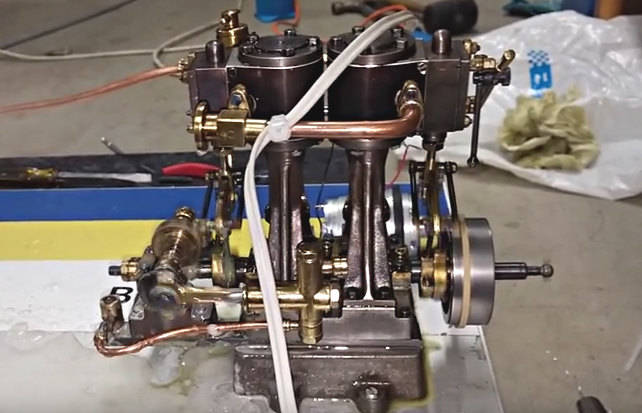This article is more than 1 year old
Swede builds steam-powered Raspberry Pi. Nowhere to plug in micro-USB, then?
All you need is a couple of blowtorches, some wire and a desk-sized steam engine
Video A Swedish schoolboy has built a miniature steam engine to power his Raspberry Pi. It is a piece of absolute engineering beauty.
Forum user “Alexzpro”, posting in Swedish on the Svenska Elektronikforumet, put up a video he had made of the power plant for his Raspberry Pi.
Alexzpro's generator is a small compound steam engine. Two propane blowtorches heat water in a copper tank – the boiler – and the steam that produces is passed to a simple two cylinder engine mounted on a metal plate.
There, the steam is fed into cylinders where it acts on pistons to turn a crankshaft (simplified explanation – see the Steamnote at the end for the full version).
The crankshaft drives a flywheel, which, as well as providing the momentum to keep the engine rotating, turns a simple DC electric motor via what looks suspiciously like a rubber band.

Look at the band, or belt, around the flywheel to the right. Also note the arrangement on the left of the base - is that a reversing gear? Answers in the comments
Electricity generated via the motor (a DC motor turned by an external force generates electricity, as every physics GCSE schoolboy knows) is then fed into a 5V regulator, which in turn powers the Pi.
Alexzpro says the steam engine's electrical output is around 17V at full speed, adding that the Pi's greater demand for juice when it boots causes a voltage drop big enough to force the mini computer to reboot.
He said that the engine is for a “school project”. El Reg suspects his dad might have given him a hand... ®
Steamnote
* Hot steam is passed into the cylinder through a regulator, or cut-off valve. The regulator shuts once a small amount of hot steam has entered into the cylinder. The steam, pushing on the piston, tries to expand. This pushes the piston down, cooling the steam as its heat energy is converted into kinetic energy – motion – through the connecting rod and the crankshaft.
The “cool” steam is then vented out of the cylinder, ready for the next charge. The exhaust is the pipe with froth dribbling from it that's bolted to the side of the engine.
